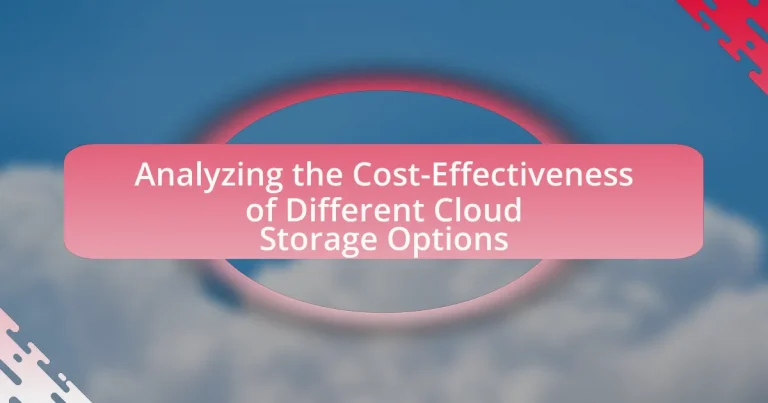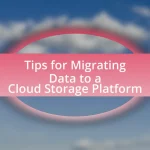The article focuses on analyzing the cost-effectiveness of various cloud storage options, including public, private, hybrid, and multi-cloud storage. It examines the pricing structures of these services, highlighting factors that influence costs such as storage capacity, data transfer rates, and redundancy options. Key features of popular cloud storage services, including scalability, security, and collaboration tools, are discussed in relation to their impact on cost-effectiveness. The article also addresses common pitfalls in selecting cloud storage solutions and offers best practices for optimizing cloud storage investments to maximize value and minimize unnecessary expenses.
What are the different cloud storage options available?
The different cloud storage options available include public cloud storage, private cloud storage, hybrid cloud storage, and multi-cloud storage. Public cloud storage, such as services offered by Amazon Web Services, Google Cloud, and Microsoft Azure, allows users to store data on shared infrastructure managed by third-party providers. Private cloud storage is dedicated to a single organization, providing enhanced security and control, often hosted on-premises or by a third-party vendor. Hybrid cloud storage combines both public and private cloud solutions, allowing for flexibility and scalability while maintaining sensitive data in a private environment. Multi-cloud storage involves using multiple cloud services from different providers to optimize performance, reduce risk, and avoid vendor lock-in. Each option has distinct advantages and cost implications, making it essential for organizations to analyze their specific needs when choosing a cloud storage solution.
How do these cloud storage options differ in terms of pricing?
Cloud storage options differ significantly in pricing based on factors such as storage capacity, features, and payment models. For instance, providers like Google Drive offer a free tier with 15 GB of storage, while paid plans start at $1.99 per month for 100 GB. In contrast, Dropbox’s basic plan provides 2 GB for free, with paid options beginning at $9.99 per month for 2 TB. Additionally, Amazon S3 employs a pay-as-you-go model, charging based on the amount of data stored and transferred, which can lead to variable costs depending on usage. These differences highlight how pricing structures can vary widely among cloud storage services, impacting overall cost-effectiveness for users.
What factors influence the pricing of cloud storage services?
The pricing of cloud storage services is influenced by several key factors, including storage capacity, data transfer rates, redundancy options, and service level agreements (SLAs). Storage capacity directly affects pricing, as larger storage plans typically cost more; for example, a provider may charge $0.02 per GB for 1 TB but reduce the rate to $0.01 per GB for 10 TB. Data transfer rates, which determine how quickly data can be uploaded or downloaded, can also impact costs, with higher speeds often resulting in higher fees. Redundancy options, such as data replication across multiple locations for reliability, can increase pricing due to the additional resources required. Lastly, SLAs that guarantee uptime and support response times can lead to higher costs, as providers invest in infrastructure to meet these commitments.
How do storage limits affect the cost of cloud storage options?
Storage limits directly influence the cost of cloud storage options, as providers typically charge based on the amount of data stored. For instance, many cloud storage services offer tiered pricing models where costs increase with higher storage capacities. A study by Gartner indicates that organizations can save up to 30% on storage costs by optimizing their data management strategies, including selecting appropriate storage limits. Therefore, understanding and managing storage limits can lead to significant cost savings in cloud storage solutions.
What are the key features of popular cloud storage services?
Key features of popular cloud storage services include scalability, accessibility, security, collaboration tools, and integration capabilities. Scalability allows users to adjust storage capacity based on their needs, ensuring they only pay for what they use. Accessibility enables users to access their files from any device with internet connectivity, enhancing convenience. Security features, such as encryption and multi-factor authentication, protect sensitive data from unauthorized access. Collaboration tools facilitate real-time sharing and editing of documents among multiple users, improving teamwork. Integration capabilities with other applications streamline workflows and enhance productivity. These features are essential for users seeking efficient and effective cloud storage solutions.
How does security vary among different cloud storage providers?
Security varies significantly among different cloud storage providers based on their encryption methods, compliance certifications, and data protection policies. For instance, providers like Google Drive and Dropbox utilize strong encryption both in transit and at rest, while others may offer less robust security measures. Additionally, compliance with standards such as GDPR, HIPAA, or ISO 27001 indicates a higher level of security commitment. For example, Amazon S3 is known for its extensive compliance certifications, which enhance its security profile. Furthermore, the implementation of multi-factor authentication and regular security audits also differentiates providers, with some offering more advanced features than others.
What additional features do cloud storage options offer that impact cost-effectiveness?
Cloud storage options offer features such as scalability, data redundancy, and tiered storage that significantly impact cost-effectiveness. Scalability allows users to adjust their storage capacity based on current needs, preventing overpayment for unused space. Data redundancy ensures that data is backed up across multiple locations, reducing the risk of data loss and associated recovery costs. Tiered storage enables users to store frequently accessed data on faster, more expensive storage while placing less critical data on slower, cheaper options, optimizing overall costs. These features collectively enhance the value proposition of cloud storage by aligning costs with actual usage and minimizing potential losses.
How can we analyze the cost-effectiveness of cloud storage options?
To analyze the cost-effectiveness of cloud storage options, one must evaluate the total cost of ownership (TCO) against the benefits provided. This involves calculating direct costs such as subscription fees, data transfer costs, and storage fees, while also considering indirect costs like maintenance and potential downtime. For instance, a study by Gartner indicates that organizations can save up to 30% on IT costs by migrating to cloud storage solutions compared to traditional on-premises systems. Additionally, comparing features such as scalability, security, and accessibility can provide insights into the value received for the costs incurred.
What metrics should be used to evaluate cost-effectiveness?
To evaluate cost-effectiveness, the primary metrics to consider are Total Cost of Ownership (TCO), Return on Investment (ROI), and Cost per Gigabyte (CPG). TCO encompasses all costs associated with a cloud storage solution, including initial setup, maintenance, and operational expenses, providing a comprehensive view of financial commitment. ROI measures the financial return relative to the investment made, indicating the profitability of the cloud storage option. CPG quantifies the cost associated with storing data, allowing for direct comparisons between different providers. These metrics are essential for informed decision-making in selecting the most economically viable cloud storage solution.
How do direct costs compare to indirect costs in cloud storage?
Direct costs in cloud storage, such as subscription fees and data transfer charges, are typically quantifiable and directly linked to the usage of the service. In contrast, indirect costs, including potential downtime, data retrieval delays, and training expenses, are less tangible and can vary significantly based on the organization’s operational efficiency and user experience. For instance, a study by Gartner indicates that indirect costs can account for up to 30% of total cloud storage expenses, highlighting the importance of considering both cost types for a comprehensive analysis of cloud storage cost-effectiveness.
What role does scalability play in assessing cost-effectiveness?
Scalability is crucial in assessing cost-effectiveness because it determines how well a cloud storage solution can adapt to increasing data demands without proportionately increasing costs. A scalable cloud storage option allows organizations to expand their storage capacity as needed, often leading to lower costs per unit of storage over time. For instance, according to a study by Gartner, companies that utilize scalable cloud solutions can reduce their overall IT costs by up to 30% as they only pay for the storage they use, rather than investing in fixed, high-capacity systems that may remain underutilized. This flexibility in scaling directly impacts the cost-effectiveness of cloud storage options, making it a key factor in financial assessments.
How do user needs influence the cost-effectiveness of cloud storage?
User needs significantly influence the cost-effectiveness of cloud storage by determining the required storage capacity, access frequency, and security features. For instance, businesses that require large amounts of data storage and frequent access may opt for higher-tier plans that offer better performance and reliability, which can increase costs. Conversely, users with minimal storage needs or infrequent access can choose lower-cost options, optimizing their expenses. Additionally, specific security and compliance requirements can lead users to select more expensive services that provide enhanced protection, thus impacting overall cost-effectiveness. Therefore, aligning cloud storage solutions with user needs ensures that organizations only pay for the features and capacity they truly require, maximizing their investment.
What types of users benefit most from specific cloud storage options?
Individuals and businesses with varying storage needs benefit most from specific cloud storage options. For instance, small businesses often find value in scalable solutions like Google Drive or Dropbox, which offer collaborative features and cost-effective plans for team projects. In contrast, large enterprises typically benefit from dedicated services like Amazon S3 or Microsoft Azure, which provide robust security, compliance, and extensive data management capabilities. Additionally, creative professionals, such as photographers and videographers, often prefer services like Adobe Creative Cloud, which integrates seamlessly with their workflows and offers ample storage for large files. These distinctions highlight how different user types leverage cloud storage based on their specific requirements and operational contexts.
How can businesses optimize their cloud storage choices for cost-effectiveness?
Businesses can optimize their cloud storage choices for cost-effectiveness by conducting a thorough analysis of their storage needs and selecting the appropriate service model. By evaluating usage patterns, businesses can identify underutilized resources and eliminate unnecessary costs. For instance, adopting a tiered storage approach allows companies to store frequently accessed data in more expensive, high-performance storage while relegating infrequently accessed data to cheaper, lower-performance options.
Additionally, leveraging cloud providers’ pricing calculators can help businesses estimate costs based on their specific usage scenarios, ensuring they choose the most economical plan. According to a report by Gartner, organizations can save up to 30% on cloud storage costs by optimizing their storage strategies and regularly reviewing their cloud usage. This data underscores the importance of continuous monitoring and adjustment of cloud storage solutions to maintain cost-effectiveness.
What are the common pitfalls in choosing cloud storage options?
Common pitfalls in choosing cloud storage options include underestimating costs, overlooking data security, and failing to assess scalability. Many users initially select a cloud service based on low upfront costs, but hidden fees can lead to higher long-term expenses. For instance, a study by Gartner indicates that organizations often face unexpected charges related to data retrieval and egress fees, which can inflate overall costs significantly. Additionally, neglecting to evaluate the security measures of a cloud provider can expose sensitive data to breaches; according to a report by IBM, 20% of organizations experience data breaches due to inadequate cloud security. Lastly, not considering future growth can result in choosing a service that lacks the necessary scalability, leading to performance issues as data needs increase.
What mistakes do users often make when selecting cloud storage services?
Users often make the mistake of not thoroughly evaluating their storage needs when selecting cloud storage services. This oversight can lead to choosing a plan that either exceeds their requirements, resulting in unnecessary costs, or underestimates their needs, causing potential data loss or the need for costly upgrades. Additionally, many users fail to consider the long-term costs associated with data retrieval and bandwidth, which can significantly impact overall expenses. According to a study by Gartner, organizations that do not assess their specific usage patterns can incur up to 30% more in cloud storage costs than necessary.
How can users avoid overspending on unnecessary features?
Users can avoid overspending on unnecessary features by carefully assessing their actual storage needs before selecting a cloud storage plan. Conducting a thorough evaluation of required functionalities, such as storage capacity, collaboration tools, and security measures, allows users to choose a plan that aligns with their specific requirements. Research indicates that many users opt for higher-tier plans that include features they do not utilize, leading to wasted expenditure. For instance, a study by Gartner found that organizations often overspend on cloud services by up to 30% due to selecting plans with excessive features. By prioritizing essential features and comparing multiple options, users can make informed decisions that enhance cost-effectiveness.
What should users consider regarding long-term costs versus short-term savings?
Users should consider that long-term costs often outweigh short-term savings when evaluating cloud storage options. While initial lower prices may seem appealing, ongoing expenses such as subscription fees, data retrieval costs, and potential scalability needs can accumulate over time. For instance, a study by Gartner indicates that organizations can incur up to 30% more in costs over five years due to hidden fees and increased usage. Therefore, a comprehensive analysis of both immediate savings and future financial implications is essential for making an informed decision.
What best practices can enhance the cost-effectiveness of cloud storage usage?
Implementing tiered storage strategies enhances the cost-effectiveness of cloud storage usage. By categorizing data based on access frequency and importance, organizations can allocate frequently accessed data to higher-cost storage while moving infrequently accessed data to lower-cost options. For instance, Amazon S3 offers various storage classes, such as S3 Standard for frequently accessed data and S3 Glacier for archival storage, allowing users to optimize costs based on their specific needs. Additionally, regularly reviewing and deleting unused or obsolete data can further reduce storage costs, as studies show that up to 30% of stored data is rarely accessed.
How can users regularly assess their cloud storage needs to ensure cost-effectiveness?
Users can regularly assess their cloud storage needs by conducting periodic evaluations of their data usage and storage requirements. This involves analyzing the amount of data currently stored, identifying unused or rarely accessed files, and forecasting future storage needs based on growth trends. Regularly reviewing billing statements and comparing costs across different cloud storage providers can also highlight potential savings. According to a report by Gartner, organizations can save up to 30% on cloud storage costs by optimizing their storage strategies, which reinforces the importance of these assessments.
What strategies can be employed to maximize the value of cloud storage investments?
To maximize the value of cloud storage investments, organizations should implement strategies such as optimizing data management, leveraging tiered storage solutions, and regularly reviewing usage patterns. Optimizing data management involves classifying and prioritizing data to ensure that critical information is stored efficiently, reducing unnecessary costs. Leveraging tiered storage solutions allows businesses to store frequently accessed data on high-performance storage while relegating less critical data to lower-cost options, thus balancing performance and cost. Regularly reviewing usage patterns helps identify underutilized resources, enabling organizations to adjust their storage plans and eliminate waste. These strategies collectively enhance cost-effectiveness and ensure that cloud storage investments yield maximum returns.


